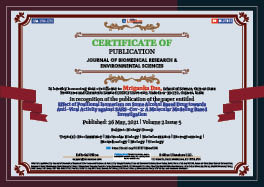Mahendiali Palsaniya, Bansari Patel, Nibedita Panigrahi, Daffodil Mohanta, Sonali Priyadarshini Parida, Dhruvin Kumar Patel, Mriganka Das* and Bidyut Kumar Kundu*
Volume2-Issue5
Dates: Received: 2021-05-17 | Accepted: 2021-05-25 | Published: 2021-05-26
Pages: 383-391
Abstract
The severe acute respiratory syndrome coronavirus 2, better known as COVID-19, has become a major health concern worldwide. It has challenged the global healthcare sector like anything. It appeared in Wuhan, China, around November 2019, had spread to almost 187 countries due to its highly contagious nature. Quarantine, isolation, mask, and other precautionary measures remain the sole obliging strategy to decline the person-to-person transmissions. Amidst the pandemic, drug repurposing by identifying therapeutically potent molecule from the collection of pre-existing molecules by molecular docking and DFT methods are certainly fast and handy. Herein, this paper is dealing with 5 hydroxy based drugs such as 5-isopropyl-2-methylphenol (Carvacrol), 3-isopropyl-6-methylbenzene-1,2-diol, 2-isopropyl-5-methylbenzene-1,4-diol, 5-isopropyl-2-methylbenzene-1,3-diol, 2-isopropyl-5-methylbenzene-1,3-diol to discover the new possible COVID-19 inhibitors. The proteases PDB, e.g., 5r7y is used as hosts to calculate the interactions with hydroxy-based drugs as guests. Our research shows that 5-isopropyl-2-methylbenzene-1,3-diol is the most active, having binding energy –6.46 kcal/mol against 5r7y of SARS-CoV-2. Hence it is assumed that increasing number of alcohol group make the system more preferable towards SARS-CoV-2 protease protein 5r7y. It was also observed that relative binding energy among these alcohol-based drugs is further tuned by their positional isomerism property.
FullText HTML
FullText PDF
DOI: 10.37871/jbres1246
Certificate of Publication

Copyright
© 2021 Palsaniya M, et al. Distributed under Creative Commons CC-BY 4.0
How to cite this article
Palsaniya M, Patel B, Panigrahi N, Mohanta D, Parida SP, Patel DK, Das M, Kundu BK. Effect of Positional Isomerism on Some Alcohol Based Drug towards Anti-Viral Activity against SARS-Cov-2: A Molecular Modeling Based Investigation. J Biomed Res Environ Sci. 2021 May 26; 2(5): 383-391. doi: 10.37871/jbres1246, Article ID: jbres1246
Subject area(s)
References
- Tu H, Tu S, Gao S, Shao A, Sheng J. Current epidemiological and clinical features of COVID-19; a global perspective from China. J Infect. 2020 Jul;81(1):1-9. doi: 10.1016/j.jinf.2020.04.011. Epub 2020 Apr 18. PMID: 32315723; PMCID: PMC7166041.
- Singh A, Shaikh A, Singh R, Singh AK. COVID-19: From bench to bed side. Diabetes Metab Syndr. Clin Res Rev. 2020; 14:277-281. doi:10.1016/j.dsx.2020.04.011.
- Shah V, Bhaliya J, Shah D. In Silico Study of 1,5-Bis(4-Hydroxy-3-Methoxyphenyl)-1,4-Pentadiene-3-One (Deketene Curcumin) on Crystallized Protein Structures of SARS-CoV-2. ChemRxiv. 2020;19:1-15. doi:10.26434/chemrxiv.12377000.
- Hu Y, Liang W, Liu L, Li L. Clinical Characteristics of Coronavirus Disease 2019 in China. N Engl J Med. 2020;18: 1708-1728. doi:10.1056/NEJMoa2002032.
- Song F. Emerging 2019 Novel Coronavirus (2019-nCoV) Pneumonia. Radiology. 2020;295:210–217. doi:10.1148/radiol.2020200274.
- Priyanka, Choudhary OP, Singh I, Patra G. Aerosol transmission of SARS-CoV-2: The unresolved paradox. Travel Medicine and Infectious Disease 2020;37:101869. doi:10.1016/j.tmaid.2020.101869.
- Chang L, Yan Y, Wang L. Coronavirus Disease 2019: Coronaviruses and Blood Safety. Transfus Med Rev. 2020;34: 75-80. doi:10.1016/j.tmrv.2020.02.003.
- Woo PCY. Discovery of Seven Novel Mammalian and Avian Coronaviruses in the Genus Deltacoronavirus Supports Bat Coronaviruses as the Gene Source of Alphacoronavirus and Betacoronavirus and Avian Coronaviruses as the Gene Source of Gammacoronavirus and Deltacoronavi. J Virol. 2012;86:3995-4008. doi:10.1128/JVI.06540-11.
- Kang S. Recent progress in understanding 2019 novel coronavirus (SARS-CoV-2) associated with human respiratory disease: detection, mechanisms and treatment. Int J Antimicrob Agents 2020;55:105950. doi:10.1016/j.ijantimicag.2020.105950.
- Yang, H, Rao MB. Drug Design Targeting the Main Protease, the Achilles Heel of Coronaviruses. Current Pharmaceutical Design 2006;12:4573-4590. doi:10.2174/138161206779010369.
- Masters PS. The Molecular Biology of Coronaviruses. Advances in Virus Research. 2006;65:193-292. doi:10.1016/S0065-3527(06)66005-3.
- Schoeman D, Fielding BC. Coronavirus envelope protein: Current knowledge. Virol J. 2019;16:69. doi:10.1186/s12985-019-1182-0.
- Li W. Bats Are Natural Reservoirs of SARS-Like Coronaviruses. Science. 2005;310:676-679. doi:10.1126/science.1118391.
- Gralinski LE, Menachery VD. Return of the Coronavirus: 2019-nCoV. Viruses 2020;12. doi:10.3390/v12020135.
- Tang, X. On the origin and continuing evolution of SARS-CoV-2. Natl Sci Rev. 2020;7:1012–1023. doi:10.1093/nsr/nwaa036.
- Priyanka, Choudhary OP, Singh I. Protective immunity against COVID-19: Unravelling the evidences for humoral vs. cellular components. Travel Medicine and Infectious Disease. 2021;39:101911. doi:10.1016/j.tmaid.2020.101911.
- Pourghanbari G, Nili H, Moattari A, Mohammadi A, Iraji A. Antiviral activity of the oseltamivir and Melissa officinalis L. essential oil against avian influenza A virus (H9N2). Virus Disease 2016;27:170-178. doi:10.1007/s13337-016-0321-0.
- Tariq S. A comprehensive review of the antibacterial, antifungal and antiviral potential of essential oils and their chemical constituents against drug-resistant microbial pathogens. Microb Pathog. 2019;134:103580. doi:10.1016/j.micpath.2019.103580.
- Terstappen GC, Reggiani A. <em>In silico</em> research in drug discovery. Trends Pharmacol. Sci. 2001;22:23-26. doi:10.1016/S0165-6147(00)01584-4.
- Ekins S, Mestres J, Testa B. In silico pharmacology for drug discovery: methods for virtual ligand screening and profiling. Br J Pharmacol. 2007;152:9-20. doi:10.1038/sj.bjp.0707305.
- Lan J. Structure of the SARS-CoV-2 spike receptor-binding domain bound to the ACE2 receptor. Nature. 2020;581: 215-220. doi:10.1038/s41586-020-2180-5.
- Zhang L. Crystal structure of SARS-CoV-2 main protease provides a basis for design of improved α-ketoamide inhibitors. Science. 2020;368:409-412. doi:10.1126/science.abb3405.
- Kumar A. Identification of phytochemical inhibitors against main protease of COVID-19 using molecular modeling approaches. J Biomol Struct Dyn. 2020;1-11. doi:10.1080/07391102.2020.1772112.
- Das M. Targeted synthesis of cadmium(II) Schiff base complexes towards corrosion inhibition on mild steel. RSC Adv. 2017;7:48569-48585. doi:10.1039/c7ra08633d.
- Das M. Enhanced pseudo-halide promoted corrosion inhibition by biologically active zinc(II) Schiff base complexes. Chem Eng J. 2019;357:447-457. doi:10.1016/j.cej.2018.09.150.
- O’Boyle NM. Open Babel: An open chemical toolbox. J Cheminform. 2011;3:33. doi:10.1186/1758-2946-3-33.
- Geerlings P. Conceptual density functional theory: status, prospects, issues. Theor Chem Acc. 2020;139:36. doi:10.1007/s00214-020-2546-7.
- Leach AR, Shoichet BK, Peishoff CE. Prediction of Protein−Ligand Interactions. Docking and Scoring:  Successes and Gaps. J Med Chem. 2006;49:5851-5855. doi:10.1021/jm060999m.
- Vieira TF, Sousa SF. Comparing AutoDock and Vina in Ligand/Decoy Discrimination for Virtual Screening. Applied Sciences 2019;9. doi:10.3390/app9214538.
- Elfiky AA, Ismail AM, Elshemey WM. Recognition of gluconeogenic enzymes; Icl1, Fbp1, and Mdh2 by Gid4 ligase: A molecular docking study. J Mol Recognit. 2020;33:e2831. doi:10.1002/jmr.2831.
- Elfiky AA. Novel guanosine derivatives against Zika virus polymerase in silico. J Med Virol. 2020;92:11–16. doi:10.1002/jmv.25573.
- Lipinski CA, Lombardo F, Dominy BW, Feeney PJ. Experimental and computational approaches to estimate solubility and permeability in drug discovery and development settings. Adv Drug Deliv Rev. 2001;46:3-26. doi:10.1016/S0169-409X(00)00129-0.